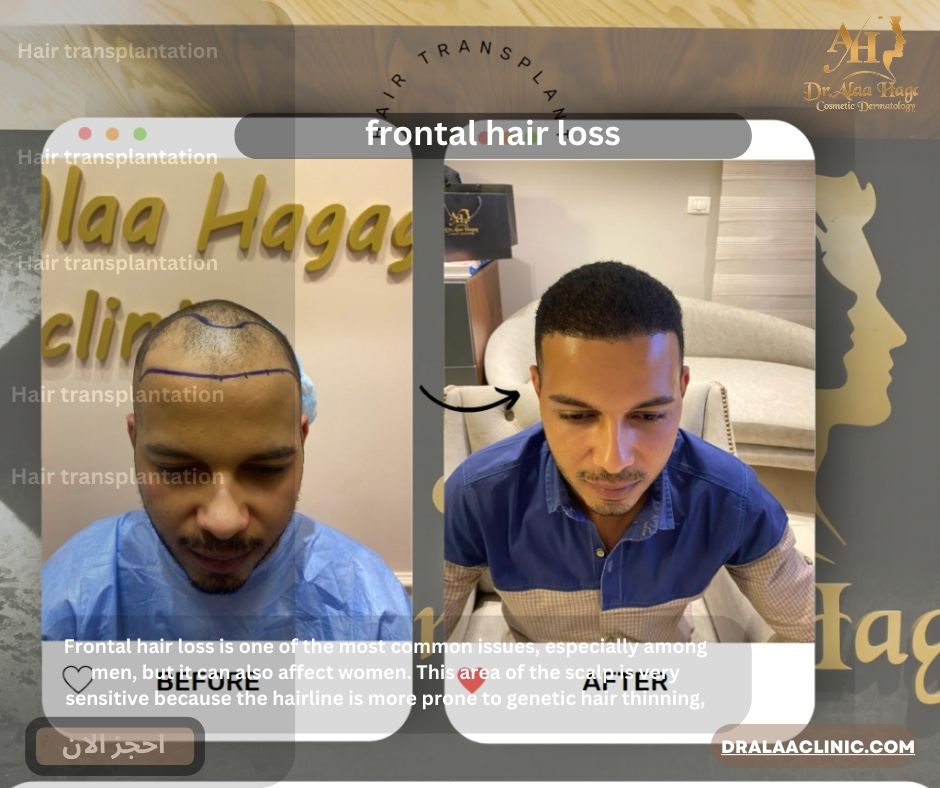Table of Contents
Frontal hair loss is one of the most common issues, especially among men, but it can also affect women. This area of the scalp is very sensitive because the hairline is more prone to genetic hair thinning, along with other factors such as stress, nutritional deficiencies, and certain skin conditions. That’s why treating frontal hair loss has become essential to maintain hair density and prevent further recession of the hairline.
? What Causes Frontal Hair Loss

The most common cause of frontal hair loss is androgenetic alopecia, which usually starts at the hairline due to the follicles’ sensitivity to the DHT hormone. Chronic stress, poor nutrition, and tension-related habits can also weaken the follicles, causing noticeable thinning at the front. Daily habits like excessive heat styling, chemical straightening, or pulling the hair tightly backwards may also worsen the problem. Skin conditions such as alopecia areata and psoriasis can contribute to more visible thinning in the frontal area.
Latest Medical Techniques for Treating Frontal Hair Loss
The rapid development of aesthetic medical treatments has made dealing with frontal hair loss easier and more effective, especially with techniques that regenerate weakened follicles instead of relying solely on hair transplantation.
G-CELL Technology
G-CELL is another regenerative treatment used for reactivating dormant hair follicles. The device processes a sample of the patient’s own tissue and extracts active regenerative cells, which are then injected into the thinning areas. This helps significantly improve hair density in the frontal region.
Mesotherapy for Hair
Mesotherapy involves injecting a blend of vitamins, minerals, and amino acids into the scalp to improve its nourishment. It is very effective for people whose frontal hair loss is linked to nutritional deficiencies or weak blood circulation. It is often used as a supportive therapy alongside main treatments.
Hair Transplantation – The Final Option
When follicles are completely inactive and do not respond to any treatment, hair transplantation becomes the most suitable solution. Modern methods like DHI and FUE offer natural results and allow precise redesigning of the frontal hairline for a fuller and more aesthetic appearance.
PRP (Platelet-Rich Plasma)
PRP is one of the most popular treatments for frontal hair loss. It uses plasma extracted from the patient’s own blood and injected into the scalp. This plasma contains growth factors that strengthen follicles and help them produce thicker hair. It requires multiple sessions and works best for cases where follicles are still alive but weak.
Exosome Therapy
Exosome therapy is one of the newest and most powerful solutions for frontal hair loss. These tiny regenerative particles send biological signals that re-activate and strengthen hair follicles much faster than traditional methods. One of the most advanced applications is autologous exosome therapy, which uses regenerative materials from the patient’s own body, ensuring high safety and excellent results for moderate frontal thinning.
Low-Level Laser Therapy (LLLT)
LLLT is a non-invasive treatment that enhances blood flow to the hair follicles and boosts their activity. It is particularly beneficial for early-stage frontal hair loss, especially for people looking for long-term maintenance.
Differences Between Treating Frontal Hair Loss in Men vs. Women
Men typically experience a clear recession of the hairline due to genetic factors, so early intervention is essential to slow down the progression. Women, on the other hand, often suffer from diffuse thinning without a dramatic hairline recession. Therefore, hormonal and nutritional treatments are more commonly included in their plans. Treatments like minoxidil work for both men and women but with different concentrations.
How to Maintain Long-Term Results After Treating Frontal Hair Loss
To maintain the results of frontal hair loss treatments, proper scalp care is essential. Avoid excessive pulling of the hair, limit heat styling, and maintain a diet rich in vitamins and protein. Monthly follow-ups with a specialist are important to monitor improvement and adjust the treatment plan. Using gentle hair products and avoiding harsh chemicals also plays a major role in preserving the hairline.
Frequently Asked Questions
?Can frontal hair loss be treated without a hair transplant
Yes. If follicles are still alive, treatments such as PRP, exosome therapy, G-CELL, and LLLT can produce excellent results.
?When should I see a doctor for frontal hair loss
If hair thinning continues for more than three months or the gaps become clearly visible, visiting a dermatologist is essential.
?Is frontal hair loss always a sign of genetic baldness
Not always, although it is a common early sign in men. In women, it may occur due to nutritional deficiencies or hormonal changes.
?Can vitamin deficiency cause frontal thinning
Yes. Deficiency in Vitamin D, iron, and zinc is among the most common causes of weakened follicles and frontal hair loss.



لا تعليق